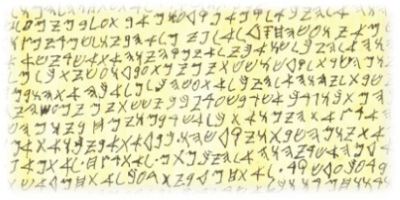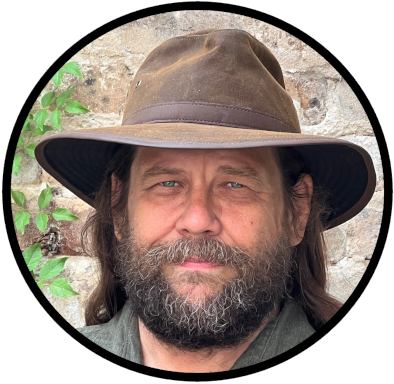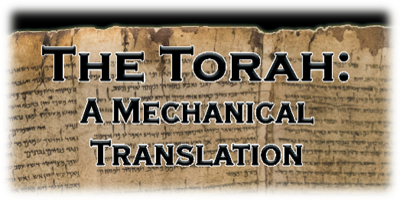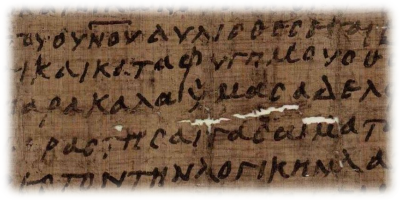Jump to:
|
Introduction The Story of the Scrolls My Correspondences with Raphah Bethyah A Review of the Original Scriptures and the Word of Yah The Photograph of the Scrolls David Gooley's Insights |
Introduction
About four years ago I received an email from an individual who had heard about a recent discovery in the deserts of the Middle East that included ancient scrolls, written in Paleo-Hebrew, and included both the Old Testament and the New Testament. This of course caught my interest and I began looking into the claim, but was unable to find out any information on this discovery. At that time I figured that if the claims were genuine, they would eventually filter down to the masses through the normal scholastic channels. But if the claims were invalid the story would simply disappear.
For years I had heard nothing on these scrolls, until recently. I received many emails from people asking my opinion of these "Original Scripture" scrolls and I was pointed to a Youtube video, which I watched.

The claims Raphah makes in this video are, at the very least, extra-ordinary, and if true would completely revolutionize our understanding of the Bible and its history. I once again began my search for more information on this subject, but again found nothing to support these claims except for Raphah's video (unfortunately made private after I and others began questioning his claims) and his websites (see below). At this point I decided to contact Raphah in an attempt to learn more about these scrolls. What I found not only surprised me, but caused me great concern for others who may be taking Raphah's claims at face value, hence the purpose of these articles on my website.
The Story of the Scrolls
The following excerpts concerning the Yahuwans discovery and translation of the Original Scriptures have been taken from the Original Scriptures web site. As you read this, keep three things in mind. First, remember that "extra-ordinary claims require extra-ordinary proof." Second, not one bit of evidence, photograph, video, documentation, independent verification, etc. has ever been presented to anyone concerning these scrolls. And third, this entire "story" has been validated by only one individual, the author of the following article, Raphah Bethyah.
In early 2002 AD an ancient buried library of 245 carefully preserved Scriptures on 1930 year old papyrii was unearthed by a team of Original Word Seekers in ancient eastern YAsarel [See Note #1] (present day Iraq), just west of the Euphrates river (Gen 15:18)... The Most High Spirit of El YAH (the RUWach) warned these eastern believers to "tell no man" until they were safely secured in a special secure "hideout" in deep natural caves Almighty YAH had prepared thousands of years ago in the HimalaYAs (mountains of The Eternal YA) mountains. They built a pole canopy covered with sand to hide their excavation and dug only at night in the desert sands.
This restoration was prophesized to begin in east YAsarel (Mt 25:27), which is today's Iraq near the west bank of the Euphrates, near Ur, the birth place of AbrAHam. This complicated the excavations because Iraq is an Islamic nation with extradiction agreements with many other countries, including the USA. However, to our advantage, El YAH blinded a thousand watching eyes on the deserts crossings and we were able to secure these precious scrolls and take them safely to our hideout in the HimalaYA's. Only three of us had passports since non-Muslims cannot get passports in most Muslim countries. But El YAH protected us and gave us great favor. When we had safely taken them back to our safe hideout in the vast HimalaYAs, we tried to negotiate with the Iraqi Islamic leaders.
As we were warned, they have accused us of stealing "Iraqi antiquities" (these manuscripts are YAsarel's) and arrested our negoitiator and tried to blackmail us. Being forewarned, they could only arrest our paid non-believing negotiator. We are presently financially poor believers but even the richest denominations could not pay their Mullah's exorbinant blackmail. The traditional Catholic, Jewish and Protestant denominational leaders all want these Original Scriptures destroyed because they embarrass most present day "scholars" and educated preachers as hypocrites and dishonest merchants of the gods! These 1st Century AbraUW and HebreW Scripture texts are for "the Seed of AbrAHam Restoration Covenant people who again are "called by His Name" and are a sacred trust to all who truly love the Word. We will protect them with our very lives while we introduce them to the world!
Enemies of The Original Scriptures are presently trying to extradite several of us back to stand trial in Iraq. Presently, true to the prophecy which warned us, these precious end time scripture texts would be immediately taken from us if we brought them into a Muslim or even western court or arena. Our enemies risk billions of their income dollars if they do not stop us! We are in a fierce spiritual war against the powers of darkness but we know Almighty El YAH is protecting us and these precious Restoration Original Scriptures.
The introductory scroll of the ROS library was in a tightly sealed clay jar out in front of the other jars. It stated that these fresh copies were made by MatithYAHUW (the real "Matthew") and his "Matithim" (Disciples) just after the fall of "Yerushalem" (70 AD) and buried in a house first built by DanYAel for the Latter Day time when restoration believers would overrule Shatan's [See Note #2] kingdoms and restore His Perfect Word, "when the knowledge of the Name of YAHUWAH would again cover the earth like the waters cover the sea!"
It also stated that these texts were exact copies of The Original Word of YAH as recieved by faithful believers over "the past 3500 to 7 years ago" (the last letter of ShaUWl/Paul was around 63 AD). They should not be handled by unbelievers "lest the wrath of YAHUWAH's Righteousness fall upon them."
Three unbelievers have tried to steal a sheet of the ROS scrolls. All three, true to the warning, died of unknown causes within 100 meters of stealing them! Although these precious Original Texts are for YAsarel, that is YAHUWan Word-lovers only, we have just published a very good (but not perfect) english translation of these Original ROS NT Manuscripts for all who are "Seekers" in process of becoming in His Loving Image. It is available for your immediate puchase by clicking on the above right picture. It is the only translation which will give you a 100% truthful [See Note #3] and crystal clear meaning of The Original Word given by your Creator for you!
Note #1: This is the Yahuwans way of transliterating the Hebrew ישראל (yisra'el). [Back]
Note #2: This is the Yahuwans transliteration of the Hebrew שטן (satan). For some reason they have chosen the "sh" sound for this shin, but have retained the "s" sound in the name YAsarel.[Back]
Note #3: Note that previously in this paragraph the author acknowledges the fact that this translation is "not perfect," but now claims that this translation is 100% truthful. [Back]
My Correspondences with Raphah Bethyah
My original eMail to Raphah Bethya.
My name is Jeff A. Benner and I run the Ancient Hebrew Research Center. I have a couple of questions if you don't mind. After researching your website, videos and comments in YouTube, you state;
- You have the original scriptures of the OT and NT in Hebrew.
- Your desire is to bring the pure word of God to the people.
- You have published an English translation of these scriptures.
- You admit that being an English translation it is not the pure word.
If your desire is to bring the pure word of God to the people, why did you choose the inferior English language to do this? If your desire is to bring the pure word of God to the people, why not publish the Hebrew text? I have received many emails asking me about the "Original Scriptures" and I am giving you an opportunity to respond before coming to any conclusions and publishing my observations and opinions. Would you be interested in any dialogue on the subject of the Hebrew text of these scrolls?
Jeff A. Benner
Ancient Hebrew Research Center
Website: http://www.ancient-hebrew.org
Email: jeffbenner@ancient-hebrew.org
YouTube: http://www.youtube.com/user/ancienthebreworg
Raphah's response.
It was wonderful to get your email Jeff. On behalf of all YAsarel United Worldwide, I want to thank you for your hard work and sacrificial spirit through your web sites. We have recommended and used them for all seekers and YAHUWans. You are great blessing to The Kingdom of YAH. By the way, I believe we are fellow Mississippians as well!
Yes, we would be delighted to discuss the ancient scriptures with you any time. I have been in AfricAH on mission for a month but do have internet on occasion for emailing. I will return to Oklahoma by 3/13, YAH willing. I would love your response and thoughts about what you have read in OSE1-KC. What do you think of the basics presented in it, especially The Way of Salvation given in the ROS texts? Since the ROS texts are specifically unique, with a roughly 76% agreement with the ben Asher text, we have only the RUWach, the comparative near-original texts, a few supporting primary texts like the MurasUW and our YAH given reason to evaluate the ROS text with. We have never seen any others quite like them but we cannot be sure they are 100% pure originals until we find two other pure Word libraries. We have twelve YAHUWans looking for the one in Egypt now. They great truth in the ROS that excites us is that we have no contraditions in the Nature verses the Law of YAH or in His applications of the Covenant Word of YAH as most of the near-original ancient translations exhibit.
We do believe MatithYAHUW 5:18, that His perfect Original Word does exist on earth. If somehow the ROS is flawed somewhere, then if we seek in love together, His Word assures us that we will find it (YAHUWchanon 14 etc)! So far, the ROS has stood up to every test we have thrown at it. Do you have any basic tests against it which we should consider?
Thanks again for your email and interest in His Eternal Truth,
Your servant under YAHUWAH,
RaphAH
What follows is the series of emails that continued between Raphah and myself. .
Raphah: Yes, we would be delighted to discuss the ancient scriptures with you any time... I would love your response and thoughts about what you have read in OSE1-KC. What do you think of the basics presented in it, especially The Way of Salvation given in the ROS texts?
Jeff: To be honest, I have some reservations and concerns about "The Word of Yah," that may or may not be valid... Before I publish [my article on "the Word of Yah"]I would like you to have the opportunity to comment on it and provide your evidences, and if possible correct my assumptions and conclusions. As one example, how did you come to the translation of "he is Amazingly Perfect" out of the letter ת in the word בראשית? If the Word of Yah is supported by a Textual Critique, then I will support it and the translation.
Raphah: Is it acceptable to include several YAHUWans in our e-logue please? Two questions please sir? Do you think Bara Esh YA is possible from Genesis 1:1? What supports your selected name for our Savior?
Jeff: The transliteration of "Bara Esh Ya" for the Hebrew word בראשית is not possible for two reasons. First, a single letter cannot represent one word in Hebrew. Secondly, "Bara Esh Ya" can only be written in Hebrew as ברא אש יה , not בר אש י as is proposed in the Word of Yah... I use the name Yehoshua (Hebrew) and Yeshua (Aramaic) for the name of the Savior based on the Masoretic Hebrew text, the LXX and the NT Greek texts.
Jeff: I would like to divide my investigation into two separate issues. 1. The Original Scriptures: The existence, date and origin of the scrolls. 2. The Word of Yah: The accuracy of the translation. An image of Genesis chapter 1 from the scrolls would suffice to make a preliminary evaluation of both #1 and #2.
Jeff: I have acquired the photo of the "Original Scriptures" you have provided to some individuals and have done some analysis of this photo and would like to share with you my findings before I publish it [I attached the article to the email]. Please feel free to contact me if you have any comments. Thank you.
Raphah: Thank you for your good partial analysis of the small photograph we use to test the honesty, love-protection for a fellow YAHUWan, translation skill, and general maturity and trustworthiness of seekers and new believer’s with. I’m very pleased that the new seeker who sent it to you was the first one in two years that has failed the important initial honesty and love-protection test... It is not a picture of the ROS manuscript but it is a recent copy of a Latter Day test given in the ROS text to help us evaluate seekers for future servant leadership in YAsarel. You are the first one to recognize that it is a recent copy of the ROS text but not the ROS manuscripts, which are reserved only for true primary Word-servants. Congratulations!... First, in order for you to translate the AbraYA Scriptures, we will have to help you... You know that "YashaYAHUW" is the name of the great prophet most quoted by our Savior. I am amazed however that you appear to be ignorant of the word "Yasha" meaning "Savior/Rescuer/Deliverer!"...
Jeff: While you are claiming I am ignorant of the meaning of "yasha," it is apparent that it is you who are ignorant of Hebrew and are clearly unable to read a word of Hebrew. Instead you are using Strong's Concordance and Dictionary to create your Hebrew vocabulary. How do I know this? Because "yasha" does not mean Savior and is not a word that ever appears in the Hebrew Bible. Yasha (ישע) is not a Hebrew a word, it is a root... As for the photograph of the "Original Scriptures," you have presented this to others in the past as an actual photograph of the text, but now that it has been revealed that this is a modern written text you are changing your story and calling it a test. Only a child will cover up a lie with another lie.
Raphah: It appears that it does not matter how many times, I remind you and others about MtYAHUW 18 (going to a brother personally first), you continually want to cc a bunch of people and do it the pagan way and grandstand. [Note that it was Raphah who originally asked to have others CCed]... Be careful in your published criticism of The ROS text. If you continue to evaluate it by that pagan Massoretic text, calling it "the Hebrew Bible", as if that is our primary source, you could face legal slander charges which you will have to prove or pay a fine for. Losing your money could help your neurons work better though! Hate for you guys to lose that lucrative Jesus money when you have worked so hard for it. Just a friendly word of advice.
Jeff: In my previous emails I mentioned that I have done some research into the Original Scriptures and the Word of Yah and before publishing any of this material I offered you a chance to respond to my specific questions and concerns. As you have decided to ignore these I have now published the material and am letting you know. If you still wish to respond to my questions and refute my findings please feel free to do so.
A Review of the Original Scriptures and the Word of Yah
I first became aware of, what the Yahuwans, also called the Kingdom of Yah and Yasarel, are calling "The Original Scriptures," about four years ago. But within the last few months many people have been asking me my opinion on this and so I have done some research into this group and what they are calling "Original Scriptures" and The Word of Yah, their translation of these Original Scriptures.
The Word of Yah
According to their websites and videos, they have discovered, in 2002, in the deserts of Iraq, hundreds of scrolls dating to about 70 AD. Among these scrolls are the entire Old and New Testaments, written in Hebrew by the Apostle Matthew. They call these scrolls "The Original Scriptures," and they claim that they have smuggled them to their secret hideaway in the Himalayas where they have translated them into English and have published their translation called "The Word of Yah."
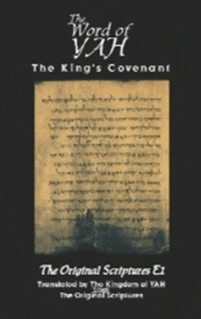
On the cover of The Word of Yah is an image of Hebrew text, which is written in the style of Hebrew used during the New Testament period. One would assume that this image is a picture from these "Original Scriptures" as this book is a translation of these scrolls. But that assumption would be incorrect as this image is not from the scrolls they claim to have found, but is in fact an image taken from the Wikimedia Commons website and is an image of a Dead Sea Scroll, specifically Psalm 145.

Why would this group, supposedly in possession of new Biblical manuscripts from Iraq, use an image from the Dead Sea Scrolls found in Israel instead of images from the scrolls within their possession? More importantly, why didn't the editors of this book explain this? Are they being deceptive in not informing the reader, allowing them to assume the origins of this image? At this time, not one image of these scrolls, or the Hebrew text from these scrolls, has ever been presented for verification or study.
Genesis 1:1
The following is Genesis 1:1 as found in "The Word of Yah."
The Creator of "The Explosion" is YA. The Creator of mankind is YA. The Son of Man is YA. The Prime Mover is YA. (Bara-Esh-YA, Bara ish YA, Bar ish YA, Baresh YA - בר אש י). He is Amazingly Perfect (Eth - ת)! He is The Almighty Loving YA of All Creation. He is Almighty Loving YA Creating "His Nation." (Eloah-YA-Im, Eloah-YA-Am - אלה י ם). He created the amazing energies which formed the ShamaYAim and the amazing energies which formed the Eartz (Bara eth Shama-YA-im eth Eartz - ברא אח שמים אח ארץ).
To someone who doesn't know Hebrew, all of this may appear to be a profound and enlightening translation, but to anyone who knows Hebrew, two very interesting discoveries are made, the complete bias on the part of the translators and their severe lack of knowledge of Hebrew. Let me demonstrate.
The First Word
Let's begin with their translation of the first word of Genesis 1:1, בראשית (bereshiyt), which they have written as בר אש י ת, dividing this word into four different words, though I use the word "word" loosely as Hebrew never has one letter for a word. The first "word" is בר (bar), which they are transliterating as "bara," which they are defining as "creator" and "bar," which they are defining as "son." As I attempt to write this, I am having difficulty in trying to explain the immense problem with their translations as they follow no logic or pattern and completely defy any sense of reason. But I will do my best to try to explain these problems.
If one who does not know Hebrew, but wanted to find the Hebrew word for "Creator," they would most likely turn to Strong's concordance and dictionary. Strong's concordance assigns the number 1254 to the word "creator." When #1254 is looked up in the dictionary, the reader is told that this is the Hebrew word ברא (bara). There are several problems with this logic, the first being that The Word of Yah is interpreting the word בר (bar, spelled beyt-resh) as ברא (bara, spelled beyt-resh-aleph), but the more serious problem is that ברא does not mean "creator." that Strong's Dictionary only provides the three-letter root of a verb, but not the many different forms of a verb. The word "creator" is always expressed in Hebrew with the participle form of the verb ברא, which is בורא (borey).
The Hebrew word בר (bar) does not mean "son," The Hebrew word for "son" is בן (ben) as found in Genesis 4:17. The word בר (bar) does mean son in Aramaic, but in Hebrew this word means "grain" and "pure."
The next "word" in The Word of Yah is אש (esh), which they are translating as explosion and man. The Hebrew word אש means "fire," and I will concede that while "explosion" is a stretch for this word, it isn't an impossible translation. "Man," however, is an even larger stretch as the Hebrew word for man is איש (iysh), not אש (esh).
Another proposed translation for בר אש (which they are transliterating as baresh) in The Word of Yah is "Prime mover," but I am at a loss to figure out how this was arrived at as "bar esh" has no connection with the idea of "prime mover" and there is no Hebrew word baresh. This is evidently a Hebrew word and definition created by the translators to promote their theology.
The next "word" is the single letter י (Y, the letter yud), which they are claiming is the word "Yah." The word "Yah" is found 49 times in the Hebrew Bible (See Exodus 15:2), but always written as יה (yah, spelled yud-hey). To claim that the letter yud represents the name "Yah" is very precarious as this letter appears tens of thousands of times in the Hebrew text.
The next "word" is the single letter ת (T, the letter tav), which they are translating as "He is amazingly perfect." Because they are transliterating this letter as "eth" I am assuming that they are correlating this letter with the word את (et), but I will comment on this a little later. I am completely mystified at how they arrived at the translation "he is amazingly perfect."
What is most revealing about The Word of Yah's translation, is that instead of translating בראשית as "in the beginning" in Genesis 1:1, they have chosen to interject a massive amount of interpretation into the word. This very same word appears in Jeremiah 26:1, but instead of translating it the same as they have done in Genesis 1:1, The Word of Yah translates it as "in the beginning."
The second word
The second word The Word of Yah translates in Genesis 1:1 is the Hebrew word אלהים (elohiym). The translators have chosen to split this word, like they did with בראשית (bereshiyt), into three different "words"-אלה י ם. The translators have consistently, throughout the translation, translated אלה (elo'ah) as "Almighty Loving," but again, they do not explain where this translation comes from and I can only conclude that it is their own personal interpretation. The י (Y, the letter yud) is again translated as the name "Yah," just as they did with the word בראשית (bereshiyt). The ם (M, the letter mem) is interpreted two different ways. One way is by transliterating the letter ם as the word "am" and translating it as "his nation." The Hebrew word עם (am) means "people" and can mean "nation," but "his people" or "his nation" would be written as עמו (amo). The other way this letter is interpreted is with the transliteration of "im" and a translation of "all creation." The word אם (im) in Hebrew means "if," and the word עים (im) means "with." The Hebrew for "all creation" is כול עולם (kol olam), so how they get "all creation" out of the single letter ם (M) is a mystery.
Throughout the entire "Word of Yah" the word אלהים (elohiym) is translated in different ways.
- Almighty loving Yah of all creation
- Almighty Yah of all creation
- Almighty Yah creating his nation
- Almighty Yah creating his people
While I wonder why the differing interpretations for the same word, I am much more interested in the fact that it is obvious the translators can't read Hebrew.
When you look up the word "God" in Strong's concordance, it assigns the number 430 to this English word and when this number is looked up in the Dictionary the reader is informed that it is the Hebrew word אלהים (elohiym). However, Strong's dictionary only provides the base word, and is unable to inform the reader that there are different forms for a noun depending on how a given word is used in a sentence.
In Genesis 9:26 the King James version reads, "And he said, blessed be the LORD God of Shem..." The Word of Yah translates this as, "He said, Blessed be YAHUWAH, Almighty loving Ya of all creation of shem..." Notice the consistent translation of "Almighty loving (אלה) Ya (י) of all creation (ם)." The problem is that the Hebrew text does not read אלהים here. Because it is written in the construct state the letter ם is dropped from אלהים (Elohiym) and is written as אלהי (elohey). If the ם (M) does not appear in this word in this verse, why do they still have "all creation" (their translation of the letter ם) within their translation? There is only one reason, they are not reading any Hebrew text, they are strictly going off of Strong's concordance and are ignorant of how the Hebrew text reads.
The next five words
The Word of Yah identifies the Hebrew text for the final five words of Genesis 1:1 as ברא אח שמים אח ארץ, which they have translated as, "He created the amazing energies which formed the ShamaYAim and the amazing energies which formed the Eartz." Let's take a look at each of these words individually. The Hebrew word ברא (bara) does mean "he created."
The Hebrew word אח (ahh) means "brother," but this is an error. The word in the Hebrew text is את (et). The letters ח (Hh, the letter hhet) and ת (T, the letter tav) are similar and this is a common mistake made by someone who does not read Hebrew very well. It is not a mistake I would expect a Bible translator to make. The word את means "plowshare" (see Isaiah 2:4) but is also used as a grammatical tool to mark the definite object of a verb. The translators of The Word of Yah chose to translate this word as "amazing energies which formed," with no explanation of why or how they came to this translation. While the word את appears over 7,000 times in the Hebrew Bible, this is the only verse in the Bible they chose to translate it in this way. In all other 7,000 times they ignore it.
Back when we were discussing the letter ת (T) in the word בראשית (bereshiyt), I commented that the translator was correlating this letter with the את. There the translator chose to translate this as "he is amazingly perfect," but now the translator is translating this word as "amazing energies which formed." The inconsistency of this translation is a clear indication that the translator is inserting much interpretation into the text without telling the reader of these insertions causing the reader to believe that this is the meaning of the Hebrew text.
The next word is שמים (shamayim), which they have simply transliterated as ShamaYAim. Notice how they have capitalized the letters "YA" in this word. The translators very frequently try to force the word "Yah" into words and names throughout the translation, even when that name is not in the text.
Next is the word אח (ahh) again, but this is again in error and should be את (et), and is again translated as "amazing energies which formed."
The last word is ארץ (erets), which they are transliterating as "Eartz."
The Hebrew Text
According to The Word of Yah the Hebrew text of Genesis 1:1 is written as follows (but removing the spaces that were inserted into בראשית and אלהים to create the one letter words and correcting the word אח to את):
בראשית אלהים ברא את שמים את ארץ
Where did this Hebrew sentence come from? It surely does not come from any Hebrew text, but as I shall demonstrate, from Strong's concordance and dictionary. The following is Genesis 1:1 as it appears in the King James Bible with the Strong's numbers inserted into the text.
n the beginning7225 God430 created1254 the853 heaven8064 and the853 earth776.
Now let's look up each of these Strong's numbers in Strong's Concordance and find out what Hebrew words are assigned to the English words in the text.
7225 - ראשית
430 - אלהים
1254 - ברא
853 - את
8064 - שמים
853 - את
776 - ארץ
Now let's put all of that into a sentence, but remember, Hebrew is read from right to left.
ראשית אלהים ברא את שמים את ארץ
Notice that this is identical (with the exception of the ב before ראשית) with the Hebrew text found in "The Word of Yah." Now let's look at the Hebrew text from the Masoretic Hebrew Bible.
בראשית ברא אלהים את השמים ואת הארץ
Notice that there are a few differences. To one who knows Hebrew, these differences prove the translators of The Word of Yah cannot read, let alone translate, Hebrew. In Hebrew, the verb precedes the subject of the verb, while in English the verb follows the subject of the verb. In The Word of Yah the Hebrew text reads "elohiym bara," but the Masoretic Hebrew text reads "bara elohiym." The Word of Yah follows the English word order, a clear indication that the translator doesn't read Hebrew.
Another clear indication that The Word of Yah is translated by someone who does not understand Hebrew is the missing letter ה (H), meaning "the," before the words שמים (shamayim-sky) and ארץ (erets-land). Because Strong's Dictionary only supplies the base word and never the prefixes attached to the Hebrew words, it is very obvious that the translator is taking his text from Strong's and not the Hebrew text. It is also important to understand that the wordאת is only used before a definite object and not an indefinite object. The words השמים (hashamayim-the heavens) and הארץ (ha'arets-the land) are definite objects (because they are prefixed with "the"), hence the word את appearing before these words. If the Hebrew text of The Word of Yah was correct, and these words were written as שמים (shamayim-sky) and ארץ (erets-land), which are indefinite objects (because they are not prefixed by "the"), the word את would not appear before these words. In fact, this is exactly how this phrase is written in Genesis 14:19 where the "the" is not prefixed to these words, and the word את does not appear before them. The Hebrew text, as written in The Word of Yah, is grammatically incorrect.
Finally, notice that the second את includes the prefix ו (W, the letter waw), which means "and." While the English translation in The Word of Yah includes the word "and," they neglected to include it in the Hebrew text, for the obvious reason that Strong's dictionary does not include this prefix and the translators can't read the Hebrew.
Conclusions
While The Word of Yah includes the Hebrew text of Genesis 1:1 within the verse, it is the only verse within the translation that actually inserts the Hebrew text, with the exception of an occasional word here and there, and I think I know why, it would have been impossible for them to do so since they are unable to read the Hebrew.
The Hebrew translations provided in The Word of Yah are unique and unorthodox to say the least, and if they are teaching Hebrew from a different perspective than everyone else, then they should at least provide an explanation of their translation methodology. Without that, the translation appears as a mish mash of jargon that has no coherent foundation or basis that was fabricated to promote the groups personal agenda, doctrines and theology.
Based on the facts that the Yahuwans have never presented any evidence to prove the existence of these extra-ordinary scrolls and their translator's complete lack of knowledge of Hebrew, I can confidently say that these scrolls do not exist and their translation is a creation of their own imaginations. Remember what Carl Sagan said, "Extra-ordinary claims require extra-ordinary evidence."
The Photograph of the Scrolls
After I began my communications with Raphah Bethyah and other Yahuwans, I received an email from Kephah who is working on a translation of The Word of Yah into Spanish for Raphah. Raphah had given Kephah a photograph of one of the scrolls. After Kephah had read some of my critiques of The Word of Yah he contacted me and sent me this photograph to get my opinion and if I felt that it was 2,000 year old Biblical scroll written in Paleo-Hebrew. Below are the front (top) reverse (bottom) of the photograph.
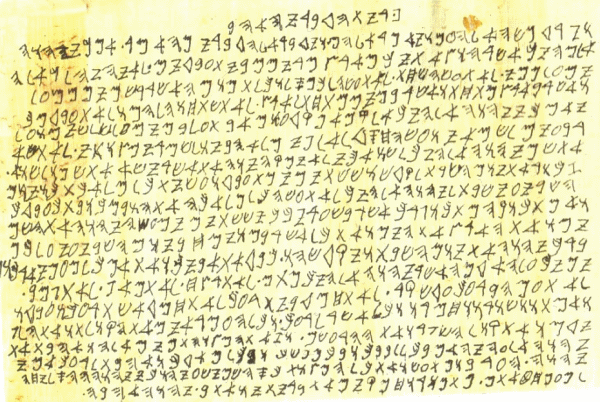
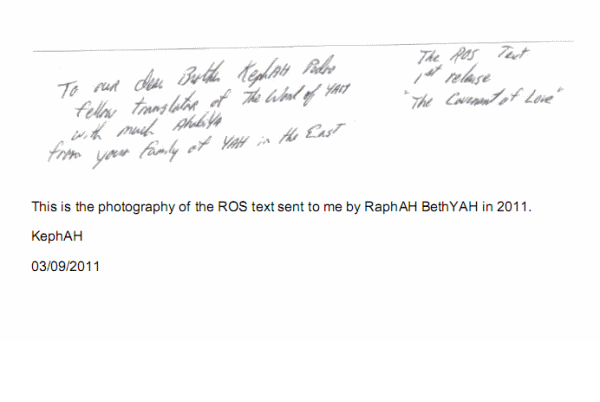
The Image above is reported to be a photograph of one of the "Original Scriptures" (OS) scroll, written by Matthew almost 2,000 years ago, buried in Iraq and discovered by the Yahuwans in 2002. Anyone who has experience with Ancient Hebrew Manuscripts will quickly recognize this text for what it is, a very poorly written forgery. However, for those who are not experienced in Ancient Hebrew manuscripts I will explain how this can easily be proven.
The Writing Surface
It is difficult to exactly determine the writing surface of the OS from a photograph, but it certainly is not vellum (animal skins) due to the presence of bands of varying colors.
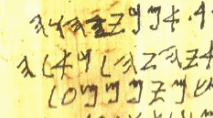
This also does not appear to by ancient papyrus as the lines of the different layers of plant material is usually well defined such as can be seen in this 1900 year old letter from Simon Bar Kochba.
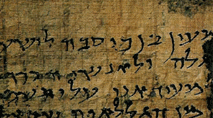
Because papyrus is made from plant material, it discolors and breaks down over time, but this is not evident in the OS photograph indicating that it is unlikely of ancient origin and appears to be modern paper parchment.
The Writing Pen
Pens of the Ancient Near East were made of reeds. The tips were thin and wide, which gave a calligraphy style to the letters.
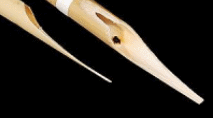
Notice the varying thickness in the lines of the letters in this text from the Dead Sea Caves.
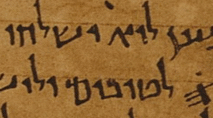
Now look at the text in the photograph of the OS. Each letter is uniform and thin and could not have been written by an Ancient Near Eastern Scribe, but is instead most probably written with a ball point pen.
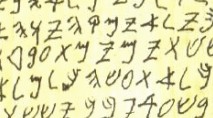
The Writing Style
Ancient Hebrew scrolls, especially for those that were to be used for holy writings, were first inscribed with lines in order to assist the scribe in keeping his lines of text vertically and horizontally straight.

The OS does not use these lines. Instead the lines begin unevenly and do not follow a straight line and would never have been done on a scroll of such importance.

The OS text is written with no spaces. It is a common held belief by many that Hebrew was originally written with no spaces or breaks between words. This is a myth and it appears that the writer of the OS believed this myth. Prior to about 600 BC words were separated by dots (see below), but from about 600 BC to the present time words have always been separated by spaces.
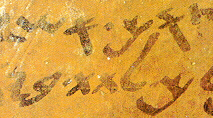
The OS text does include "dots," but ironically these "dots" look like periods.

Periods did not exist in Hebrew manuscripts until very recently, but interestingly, all of the "periods" in the OS are in the exact same place as they appear in Modern Hebrew Bibles. In the image above, the center line includes three dots, and reads, "you shall not kill 'period', you shall not commit adultery 'period', you shall not steal 'period.'"
The Script
The script used in the OS is Paleo-Hebrew, a common writing style from about 600 BC to the first century AD. While each individual has his own writing style, the characteristics of the letters remain the same. This is true for us today as well as for scribes 2,000 years ago. For the most part, the Paleo-Hebrew alphabet is very consistent in how the letters are written. The Paleo-Hebrew in the OS is similar to the Paleo-Hebrew of the first century, but there are a few major differences that cause one to question the knowledge of Paleo-Hebrew by the one doing the writing.
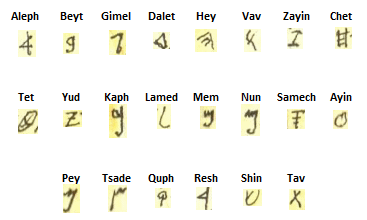
The beyt, kaph, lamed, nun, pey and shin are similar to Paleo-Hebrew, but vary enough to question the text. The shin for example is the style used in the square Aramaic script (Modern Hebrew) and would never have appeared in a text written in Paleo-Hebrew. In one instance the shin includes the dot over the left leg to represent the "s" sound (![]() ), but this dot was not invented until 1000 AD.
), but this dot was not invented until 1000 AD.
The Title

The OS includes a title that is centered at the top of the page. Hebrew manuscripts from the first century never include "titles."
The first letter in this sentence is written as ![]() , which looks like a modern "beyt" rather than the paleo-Hebrew beyt that is used in the rest of this text. In addition, this letter includes the dagesh (dot), which is a problem as the dagesh was not invented until around 1000 AD.
, which looks like a modern "beyt" rather than the paleo-Hebrew beyt that is used in the rest of this text. In addition, this letter includes the dagesh (dot), which is a problem as the dagesh was not invented until around 1000 AD.
It appears that the title (ברית הדבר יה אהב) is supposed to say something like "The covenant of the words of Yah's Love," but it doesn't. In fact it really doesn't make any sense. It is very clear that the writer did not know Hebrew syntax or grammar and it looks like he plucked the desired words out of a dictionary. If you look up the words covenant, words, Yah and love in Strong's dictionary and strung them together you will get exactly what is in the title. If the title was in fact meant to say "The covenant of the words of Yah's love," then it should have been written thusly, ברית דברי אהבה יה.
The Text
The text in the OS begins with Exodus 19:25 and continues through all of the Ten Commandments and is copied straight out of the Codex Leningrad, but is clearly done by someone who cannot read Hebrew as there are many obvious mistakes that could only be made by one not familiar with Hebrew.
One common error in the OS is the omission of letters in words. In Exodus 20:2 (see the image of the OS at the bottom of the document with the verse numbers added in) is the word ![]() (מרים), which is a misspelling for the word מצרים (mitrayim / Egypt). The name YHWH appears several times in the text as
(מרים), which is a misspelling for the word מצרים (mitrayim / Egypt). The name YHWH appears several times in the text as ![]() (יהוה), but in Exodus 20:7 it is misspelled as
(יהוה), but in Exodus 20:7 it is misspelled as ![]() (יוה). Besides these, there are dozens of other examples.
(יוה). Besides these, there are dozens of other examples.
In some cases words are misspelled. In the Codex Leningrad, Exodus 20:2 begins, אנכי יהוה אלהיך (anoki YHWH Eloheykha), which means "I am the Lord your Elohim (God). But in the OS this phrase appears like this.

The phrase is identical, except that the letter מ (mem) is inserted into the word elohim by accident.
Another common error in the OS is the complete omission of whole words. An example can be found in Exodus 20:4, where the final phrase in the OS reads, וידבר אלה הדברים ה אמר, which is gibberish, until we add in the missing words (underlined) that can be found in the Codex Leningrad, וידבר אלהים את כל הדברים האלה לאמר.
Exodus 20:4 is particularly troubling as it duplicates words, omits words and places some words in the wrong place.
All of these errors, when combined, render the text almost completely unintelligible.
Hebrew Spelling
Around 1000 AD a group called the Masorites invented a system of dots and dashes (called nikkudot) to represent the vowel sounds. All Hebrew Bibles from then until now, including the Codex Leningrad, include these nikkudot. In the Hebrew Bible is the word לֹא (lo), meaning "not," and is the word used in the Ten Commandments for, you shall "not" kill. The dot between the lamed and the aleph represents the "o" sound. Many people believe that if you remove these vowel pointings the original spelling of Hebrew words are restored. This is also a myth, and a myth that the writer of the OS believed. Hebrew words are spelled differently in the first century. While the word "lo" is written with two letters in vowel pointed texts (lamed and aleph), it is written with three letters (lamed-vav-aleph) where the letter vav represents the "o" sound. In almost every instance where the Modern Hebrew Bible has the dot for the "o" sound, the first century texts will have the letter vav in its place. Even the word Elohim is written with the letter vav in first century Hebrew manuscripts and is written as אלוהים, whereas in the later Hebrew Bibles that include the vowel points it is written as אֱלֹהִים, with the dot appearing between the lamed and hey.
The OS follows the spellings of the Modern Hebrew Bibles and never follows the spelling of words as used in the first century, also proving that the text was written recently.
David Gooley's Insights into Ralph Bathea and the Word of Yah
When I first learned of the Word of Yah aka King's Covenant, I was very interested since this would be like a dream come true. However, I started to notice some discrepancies in what Ralph aka Raphah was saying. The biggest discrepancy was Ralph's theological beliefs. Every time he would say יהוה didn't command something, it was the exact opposite of what the Scriptures stated. Some of Ralph's theological beliefs included Abraham was never commanded to offer up Yitshaq, commonly known as Isaac, slavery was never commanded and marriage to more than one woman was never permitted. Genesis 22:1-2, Exodus 21:1-6 and Exodus 21:10-11 are some references that refute Ralph's theological beliefs.
In the original video Ralph produced about the expedition, which soon after he changed its status from public to private, causing skepticism and suspicion, Ralph gave an elaborate story about how he and his group found a dome with a keystone that had the ancient/paleo Hebrew form of יהוה inscribed on it. He proceeded to explain that the room was filled with sand, so he and his group emptied out the room, but found no scrolls. There was a little sand remaining on the floor, and Ralph stated that when he moved the sand away from that area, another keystone with the ancient/paleo Hebrew form of יהוה inscribed on it was there. Ralph finished his story by saying that upon removal of the second keystone, the scrolls were in this other room. In all of this explanation, there was no indication that he video recorded any of the expedition. In 2002 when Ralph claimed to discover the scrolls, there was sufficient video recording technology that would have provided a preserved video account of the expedition. Something like this would be considered very significant and even Michael Rood produced video evidence of Pharaoh's chariots at the bottom of the sea where Mosheh and the Yisraelites crossed when the water was parted when Michael Rood announced that he had found Pharaoh's chariots. You can see the DVD for sale at www.michaelrood.tv.
I and many others requested to see the scrolls from Ralph as evidence of his claim. In every request I saw, Ralph would redirect people to purchase an overpriced copy of his translation, which was later discovered to be a modification of another English translation. Naturally people were getting frustrated because of Ralph's skeptical and suspicious behavior. I sent suggestions on how to show the evidence of the scrolls, which were as follows:1) Scroll through each scroll slowly, recording the entire scrolling with 1080p video recording to preserve the content with high-definition.2) Scan each section of each scroll with very high-resolution at 2400 dpi x 2400 dpi and then print each scan as a PDF, which would reduce the file size while retaining the original scan quality, and then combining all scans for the same scroll into a single PDF. With either of these processes, they could be sent via www.yousendit.com. If the files were larger than the 100 MB limit for free users or 2 GB limit for premium users, the files could have been divided into parts. Naturally, Ralph never acknowledged these suggestions.
It is my personal opinion that Ralph's intention was to act like a salesman to promote his own theology through his own translation, proverbially dangling a carrot in front of a donkey to keep a person interested enough. Ralph frustrated many while completely deceiving others to the point they will not recognize Ralph for what he truly is, which is a deceiver and a false teacher (due to his claims that יהוה didn't command things when יהוה actually did). Ralph transgressed the Torah of יהוה, not only according to Deuteronomy 4:2 and 12:32, which states you do not add to or diminish any of the Words of יהוה, but also transgressing the 9th Command according to Exodus 20:16, which bearing false witness against the most important neighbor of all, who is יהוה.
In conclusion, even if Ralph repents, he has totally destroyed any credibility he may have had. Not only was he unwilling to show any evidence of the scrolls he claimed to find, he was too proud and deceived by his own theology to repent. The only way Ralph can redeem himself is by providing the evidence of the scrolls if he actually does have them according to what I suggested. Otherwise, Ralph has become a disreputable, discredited and irrelevant afterthought by his own words and behavior. Even if what is evident that Ralph never had the scrolls to begin with, or even if Ralph actually does have the scrolls he claimed to find, it won't matter due to Hebrews 8:10 since the commands and Words of יהוה will be written in my mind and on my heart according to the nature of the new covenant between יהוה and His set apart nation known as Yisrael.
David Gooley
Like what you’re discovering? Continue the journey from Bible reader to translator.
|



